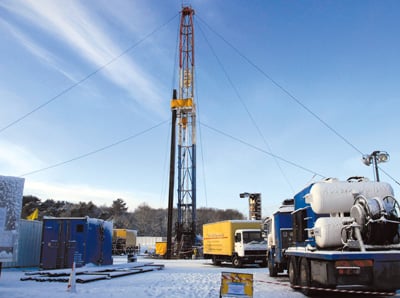Union Jack Oil plc (LON:UJO) a UK focused onshore hydrocarbon production, development and exploration company has announced initial results of the modelled flow rate analysis by RPS Group (“RPS”) and the fluid analysis carried out on fluids produced to surface during the West Newton Extended Well Test (“EWT”) programme carried out in H2 2021.
Highlights
· Independent study by RPS Group* indicates initial average potential production rates of up to 35.6 million cubic feet of gas per day (“mmcfd”) (5,900 barrels of oil equivalent per day “boepd”) from a horizontally drilled well situated in the gas zone, based on the data from West Newton A-2 well
· Study also indicates initial average potential production rates of 1,000 barrels of oil per day (“bopd”) from a horizontally drilled well situated in the oil zone based on data from West Newton A-2 well
· Fluid analysis confirms that hydrocarbon liquids recovered to surface are low specific gravity, low viscosity, light oil or condensate with an API ranging from 45.9 to 49 degrees, and that gas recovered to surface is good quality with high heat content
Independent Review of West Newton Flow Rate Potential
Following the completion of the West Newton EWT in Q4 2021, the project operator, Rathlin Energy Limited (“Rathlin”), commissioned RPS, a highly regarded independent consultant, to produce a review that assessed well productivity potential from the West Newton project, and the investigation of optimised drilling and well completion methodologies.
The RPS review concluded that the Kirkham Abbey reservoir could deliver substantially higher production rates from horizontal wells compared to vertical wells. The report also concluded that, based on RPS modelling, most of the acid stimulation carried out during the EWT only interacted with a small section of the perforated intervals due to the permeability contrast across the Kirkham Abbey formation in both wells. This suggests that potential flow rates from wells in the Kirkham Abbey reservoir would benefit from a conventional optimised acid stimulation programme that includes active diversion techniques.
The analysis was based on a comprehensive suite of data provided from operations to date at West Newton, including logs, core data, petrophysical analyses, drilling and completion information, stock tank oil analysis, and other existing third-party reports.
The RPS report modelled potential flow rates from the Kirkham Abbey reservoir, assuming horizontal drilling, similar acid concentrations and diluted volumes per interval as utilised during the EWT operations and an optimised acid-based stimulation programme, the results of which are tabled below.
| Modelled West Newton (A-2 Location) Initial One Month Average Production Potential Per Day | |||
| Phase | Well and Completion Type | Average Daily Production | |
| Gas | Vertical Well Optimised Acid Stimulation | 1.8 | mmscfd |
| Gas | Horizontal Well Optimised Acid Stimulation | 35.6 | mmscfd |
| Oil | Vertical Well Optimised Acid Stimulation | 64 | bopd |
| Oil | Horizontal Well Optimised Acidl Stimulation | 1,000 | bopd |
The RPS modelling does not take into account any potential contribution to productivity resulting from the natural fracturing that has been identified within the Kirkham Abbey reservoir. Rathlin management’s belief is that natural fracturing is likely to be present within future completion zones, which may further enhance well productivity.
More detailed evaluation is required to support this flow rate potential as well as the economic feasibility of horizontal wells, including an assessment of longer-term production rates. A number of additional workstreams and studies are currently underway, the results of which will enable the compilation of the next work programme at West Newton.
Analysis of Fluids Recovered from the EWT
A number of natural gas and liquid hydrocarbon samples were collected and analysed from both the West Newton A-2 well and the West Newton B-1z well. The natural gas had measured specific gravities of 0.63; a methane content of ca 90 per cent. and an ethane content of ca 4.5 per cent.
The liquid hydrocarbons measured API gravities between 45.9o and 49o indicating a very light oil or condensate. The samples also displayed a low viscosity measured at between 0.80 centipoise at 40o C, 0.91 centipoise at 25o C.
Executive Chairman of Union Jack, David Bramhill, commented: “We are encouraged by the RPS review which continues to underline West Newton’s potential as a material hydrocarbon producer.
“This initial analysis confirms the significance of the in-place resource and crucially, has de-risked the project by indicating the potential recovery of what we can now confirm to be high quality light oil, in addition to good quality gas.
“The mass of data obtained from the operation has allowed the modelling of potential flow rates, independently assessed for the first time.
“Ultimately, all of the analysis currently being undertaken is aimed at reducing risk and providing the Joint Venture with sufficient data to develop our forward plan for the next phase of activity at West Newton.
“Further work, including lab-based analysis of the core under reservoir conditions is underway, which will further inform optimal future drilling and completion methods at West Newton.
“We look forward to providing further updates in due course.”



































